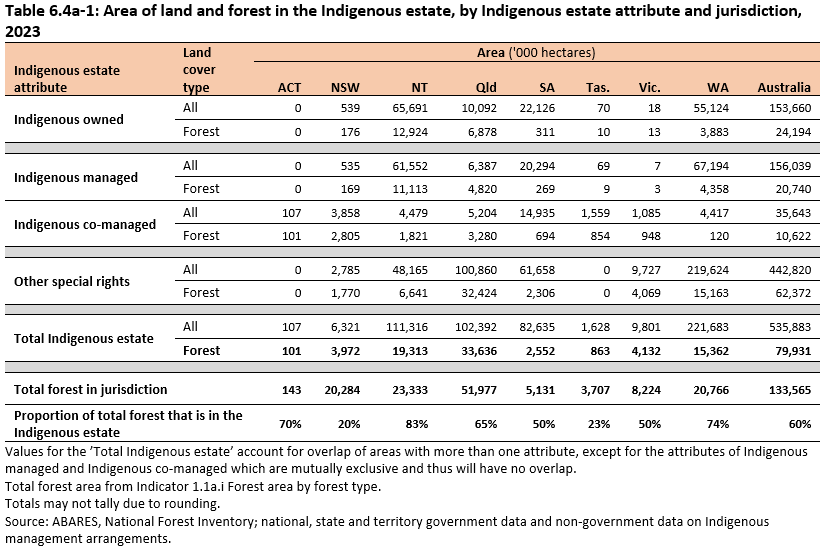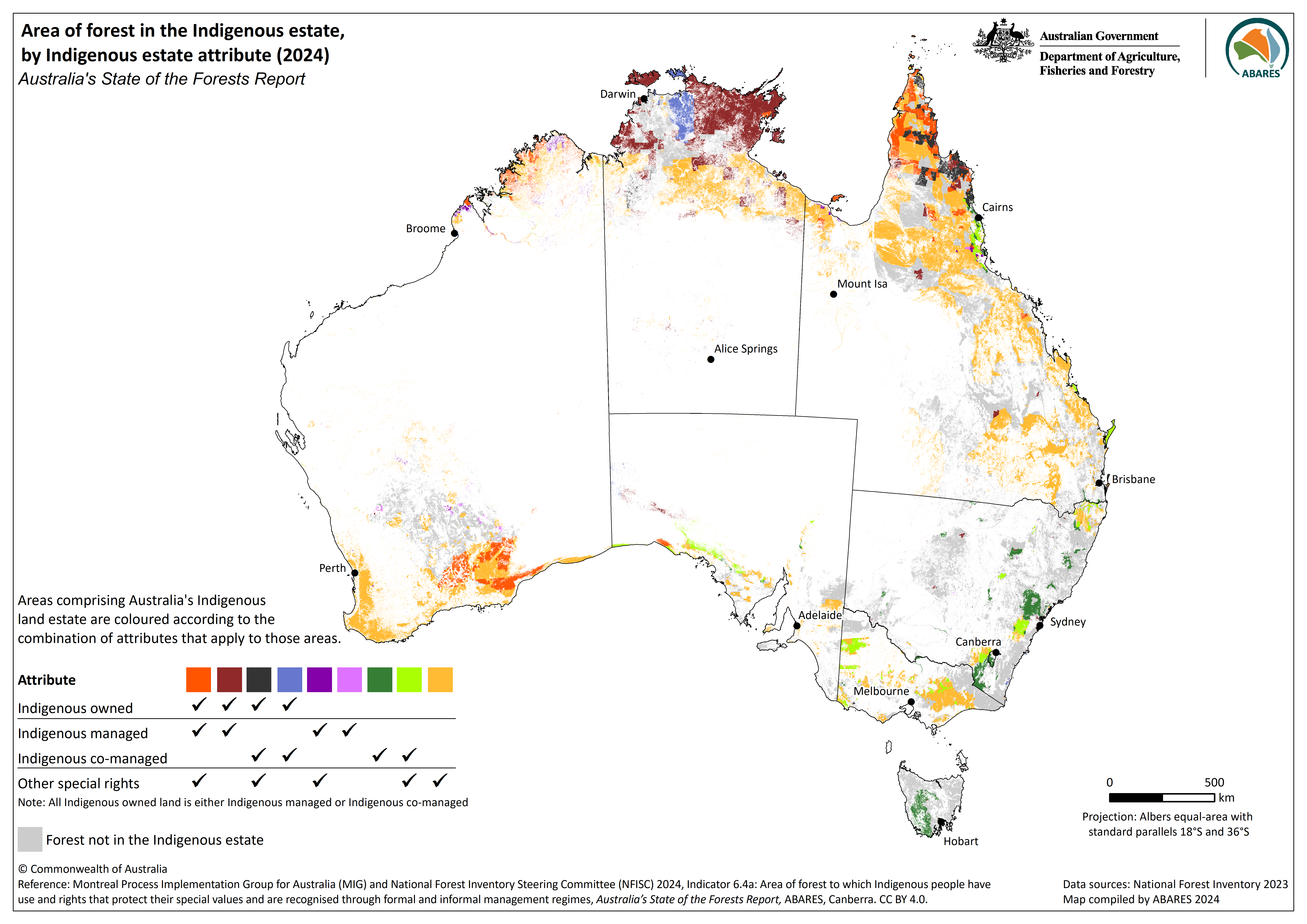This indicator monitors the degree to which land is placed under appropriate tenure classifications or management regimes to protect Indigenous peoples’ values in forests. An acceptable level of accountability for the protection of Indigenous peoples’ cultural, religious, social and spiritual needs and values is an essential part of forest management.
This is the Key information for Indicator 6.4a, published October 2024.
- The Indigenous forest estate is the forest over which Indigenous peoples and communities have ownership, management or co-management, and/or rights of use for customary purposes, and occurs across all public and private tenures.
- The Indigenous forest estate comprises 79.9 million hectares of forest, representing 60% of Australia’s total forest area in 2023.
- The Indigenous forest estate area has increased by 10.4 million hectares since 2018, resulting mainly from new Indigenous Protected Areas, Indigenous Land Use Agreements and areas subject to Native Title.
The Indigenous estate dataset captures the range of management arrangements between Indigenous peoples and land and forest across all public and private land tenures. The process for assembling and reporting Australia’s Indigenous land and forest estate is described in Jacobsen et al. (2020), which applies an updated methodology to that used for Australia’s State of the Forests Report 2018. The updated methodology reports individually the four Indigenous estate attributes:
Indigenous ownership
- Indigenous owned – Freehold land or forest that is owned by Indigenous communities, or land or forest for which ownership is vested through other mechanisms.
Indigenous management arrangement
- Indigenous managed – Land or forest that is managed by Indigenous communities, or
- Indigenous co-managed – Land or forest that has a formal, legally binding agreement in place to include input from Indigenous people in the process of developing and implementing a management plan.
Other special rights for Indigenous peoples and communities
- Other special rights – Land or forest subject to Native Title determinations, registered Indigenous Land Use Agreements and legislated special cultural use provisions.
Land and forest in the Indigenous estate will have one, and likely more, of these four attributes (except for the management attributes of 'managed' and 'co-managed' which are mutually exclusive). As such, the cumulative area of land with these attributes is greater than the total Indigenous estate. Spatial analysis is therefore required to calculate the total Indigenous estate to prevent double counting of areas subject to more than attribute.
The Indigenous estate covers 536 million hectares of land, of which 79.9 million hectares is forest in 2023 (taken together and accounting for overlaps of areas that are in more than one attribute). This represents 60% of Australia’s total forest area of 134 million hectares in 2023 (Table 6.4a-1).
By jurisdiction the largest areas in the Indigenous forest estate occur in Queensland (33.6 million hectares), the Northern Territory (19.3 million hectares) and Western Australia (15.4 million hectares) and together comprise 85% of the total Indigenous forest estate (Table 6.4a-1). Figure 6.4a-1 shows the distribution of the Indigenous forest estate across Australia.
The Indigenous forest estate in 2023 includes the following, noting that these areas should not be totalled as double counting will occur for areas having more than one attribute:
- 24.2 million hectares of forest attributed as Indigenous owned
- 31.4 million hectares of forest subject to an Indigenous management arrangement with
- 20.7 million hectares attributed as Indigenous managed and
- 10.6 million hectares attributed as Indigenous co-managed
- 62.4 million hectares of forest subject to other special rights.
Click here for a Microsoft Excel workbook of the data for Table 6.4a-1.
To report the change in the area of the Indigenous estate, the methodology described in Jacobsen et al. (2020) was applied to the data used to report the Indigenous estate in Australia’s State of the Forests Report 2018 and also to data current to 2023, thus providing for direct comparison between to the time series and the Indigenous estate attributes therein.
The 536 million hectares of land in the Indigenous estate in 2023 is an increase of 98.2 million hectares from 2018. This change includes an increase in the area of land that is Indigenous owned, an increase in the area with an Indigenous management arrangement, and an increase in the area subject to other special rights. The 79.9 million hectares of forest in the Indigenous estate in 2023 is an increase of 10.4 million hectares from the 69.5 million hectares of forest in the Indigenous estate in 2018. As with the increase in the Indigenous land estate, the increase in the Indigenous forest estate includes an increase in the area of forest land that is Indigenous owned, an increase in the forest area with an Indigenous management arrangement, and an increase in the forest area subject to other special rights, rather than an expansion of forest on the Indigenous land estate.
The area of forest that is Indigenous owned increased by 2.2 million hectares between 2018 and 2023, and forest that is Indigenous managed (either Indigenous managed or Indigenous co-managed) increased by 2.7 million hectares. Both increases occur mostly through the expansion of the network of Indigenous Protected Areas.
The area of forest subject to other special rights increased by 12 million hectares between 2018 and 2023, through the registration of new Indigenous Land Use Agreements and recognition of Native Title claims.
These increases also include some areas previously reported in the Indigenous estate but under other attributes.
Jacobsen R, Howell C, Read SM (2020). Australia’s Indigenous land and forest estate: separate reporting of Indigenous ownership, management and other special rights, ABARES technical report, Canberra, December. CC BY 4.0. doi.org/10.25814/bqr0-4m20


